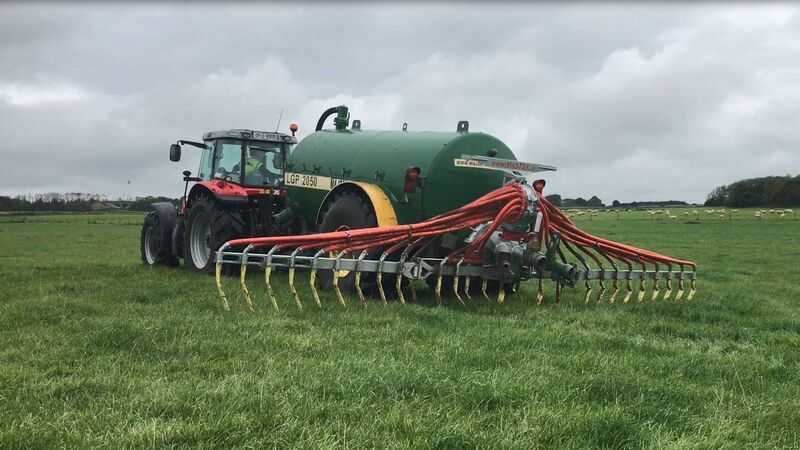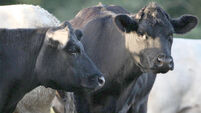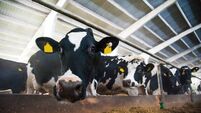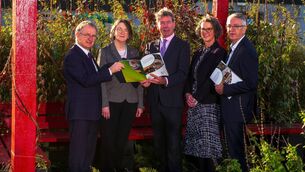New measures to address the slurry storage deficit on 40% of dairy farms

From 2022, all newly constructed external slurry stores must be covered.
There is a slurry storage deficit on approximately 40% of dairy farms, according to the Department of Agriculture.
Farmers wishing to apply for a nitrates derogation must have the legal minimum slurry storage capacity in place in order to be eligible.
Farmers at a lower stocking rate or who do not want a derogation must retain at least minimum legal capacity.
Reduced storage, through outwintering in accordance with the regulations, will only be allowed on farms with a stocking rate of less than 100kg of nitrogen per hectare.
This is one of a number of new measures to address the slurry storage deficit in the preparation of the next Nitrates Action Programme, to start next year.
The DAFM says the addition of soiled water to slurry tanks is causing many of the issues related to storage capacity across the country.
To address this, it is proposed that soiled water must be collected and kept separate from slurry on all holdings.
All holdings producing soiled water must have at least four weeks’ storage in place by 2025.
From January 1, 2023, farmers stocked at over 170 kg N/ha must demonstrate clear separation of slurry and clean water management in the farmyard.
From January 1, 2022, all newly constructed external slurry stores must be covered.
All existing external slurry stores should be covered as soon as practically possible, but no later than the end of 2027.
The Department of Agriculture, Food and the Marine (DAFM) cannot grant aid storage to reach compliance levels. However, grants are available for the installation of additional slurry storage on farms, to future-proof requirements.
In conjunction with these measures, bans are proposed on spreading slurry after September 15 and soiled water between November 15 and January 15.
About 2,000 nitrates-related inspections are carried out annually by Local Authorities and the DAFM. The DAFM says the level of compliance with regulations varies from county to county, but it is generally considered to be low, relative to other national legislation.
Submissions received during the Nitrates Action Programme first consultation stage, and discussions with local authority personnel suggested that reform of enforcement of regulations is required.
The DAFM has also commenced developing legislation for a register of chemical fertiliser sales, for accurate tracking, and a more realistic picture of where fertiliser is being applied to land. It is likely to be in place towards the end of 2022.
It will also help for better understanding of the value of livestock manure, and the need to re-use nutrients as much as possible. Along with the recently launched online slurry movement register, it will bring a level of regulation needed to ensure chemical fertilisers are used efficiently.
The DAFM says most farmers apply chemical fertilisers efficiently and in compliance with regulations, but inter-farm movement and stockpiling of fertiliser prevents accurate calculation of chemical fertiliser loadings on farms.
The proposed new register will place the responsibility on merchants to register fertiliser sales against farmers’ herd numbers, to be reported periodically to the DAFM.
In conjunction with these measures, it is proposed that nitrogen allowances for grassland are reduced gradually by 10% nationally and potentially up to 15% in the areas of highest nitrate pollution impact potential.
Also, the period when the application of chemical fertilisers to land is prohibited will be extended. No change is proposed in the September 15 to January 31 prohibition of chemical fertilisers in counties Carlow, Cork, Dublin, Kildare, Kilkenny, Laois, Offaly, Tipperary, Waterford, Wexford and Wicklow. But an extension to February 3 is proposed for counties Clare, Galway, Kerry, Limerick, Longford, Louth, Mayo, Meath, Roscommon, Sligo and Westmeath, and to February 19 in counties Cavan, Donegal, Leitrim and Monaghan.
Also, additional chemical fertiliser allowances for certain tillage crops will be reviewed.
And further new proposals may follow the imminent publication by Teagasc of a report entitled ‘The Impact of Nitrogen Management Strategies within Grass Based Dairy Systems’. The results will inform potential measures in the final Nitrates Action Programme, and derogation.









